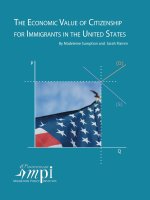Developing marketing strategy for VNShop in the e commerce market
Bạn đang xem bản rút gọn của tài liệu. Xem và tải ngay bản đầy đủ của tài liệu tại đây (2 MB, 77 trang )
ĐẠI HỌC QUỐC GIA HÀ NỘI
KHOA QUẢN TRỊ VÀ KINH DOANH
---------------------
VŨ NĂNG LỰC
DEVELOPING MARKETING STRATEGY
FOR VNSHOP IN THE E-COMMERCE MARKET
XÂY DỰNG CHIẾN LƯỢC MARKETING
CHO CÔNG TY VNSHOP
TRONG THỊ TRƯỜNG THƯƠNG MẠI ĐIỆN TỬ
LUẬN VĂN THẠC SĨ QUẢN TRỊ KINH DOANH
Hà Nội - 2017
ĐẠI HỌC QUỐC GIA HÀ NỘI
KHOA QUẢN TRỊ VÀ KINH DOANH
---------------------
VŨ NĂNG LỰC
DEVELOPING MARKETING STRATEGY
FOR VNSHOP IN THE E-COMMERCE MARKET
XÂY DỰNG CHIẾN LƯỢC MARKETING
CHO CÔNG TY VNSHOP
TRONG THỊ TRƯỜNG THƯƠNG MẠI ĐIỆN TỬ
Chuyên ngành: Quản trị kinh doanh
Mã số: 60 34 01 02
LUẬN VĂN THẠC SĨ QUẢN TRỊ KINH DOANH
NGƯỜI HƯỚNG DẪN KHOA HỌC: TS. TRẦN HUY PHƯƠNG
Hà Nội - 2017
DECLARATION
The author confirms that the research outcome in the thesis is the result of
author’s independent work during study and research period and it is not yet
published in other’s research and article.
The other’s research result and documentation (extraction, table, figure,
formula,
and other document) used in the thesis are cited properly and the
permission (if required) is given.
The author is responsible in front of the Thesis Assessment Committee,
Hanoi School of Business, and the laws for above-mentioned declaration.
Date…………………………..
Author
Vu Nang Luc
i
ACKNOWLEDGEMENT
I would first like to thank my thesis advisor PhD. Tran Huy Phuong of the
HSB. The door to Prof. Phuong office was always open whenever I ran into a
trouble spot or had a question about my research or writing. He consistently allowed
this paper to be my own work, but steered me in the right the direction whenever he
thought I needed it.
I would also like to acknowledge support of Mr Thinh former manager at
VNPaya introducing me to VNShop and also provide me many important
information and data for this research and I am gratefully indebted to him for his
very valuable comments on this thesis. I also want to say thank you to all staff at
HSB who guide me through all administrative process for the thesis.
This accomplishment would not have been possible without them. Thank you.
ii
TABLE OF CONTENTS
DECLARATION .........................................................................................................i
ACKNOWLEDGEMENT ......................................................................................... ii
ABBREVIATION ....................................................................................................... v
LIST OF TABLES .....................................................................................................vi
LIST OF FIGURES ................................................................................................. vii
INTRODUCTION....................................................................................................... 1
1.
Research Rationale ..............................................................................................1
2.
Aims of research .................................................................................................2
3.
Objects of research ..............................................................................................3
4.
Scope of research ................................................................................................3
5.
Research methodology ........................................................................................3
6.
Structure of the thesis ..........................................................................................5
Chapter 1 - THEORETICAL BACKGROUND ......................................................... 6
1.1. Strategy ................................................................................................................6
1.1.1. Definition of strategy ....................................................................................6
1.1.2. Types and levels of strategy ..........................................................................8
1.2. Marketing strategy .............................................................................................10
1.2.1. Marketing ....................................................................................................10
1.2.2. Marketing strategy ......................................................................................10
1.3. Building marketing strategy ...............................................................................15
1.3.1. Analysis of Mission and Vision of company ..............................................19
1.3.2. External analysis .........................................................................................19
1.3.3. Internal analysis ..........................................................................................22
1.3.4. SWOT analysis............................................................................................23
1.3.5. Assess and select the strategy .....................................................................24
Chapter 2 – CURRENT SITUATION OF VNSHOP MARKETING ...................... 26
2.1. About VNPay .....................................................................................................26
iii
2.2. VNPay Shop .......................................................................................................28
2.3. Current situation of marketing activity at VNShop ...........................................29
2.3.1. Current segmentation and target .................................................................29
2.3.2. Product offering categories vs competitors .................................................31
2.3.3. Current channel and potential customers ....................................................32
2.3.4. Communication and advertising .................................................................33
2.3.5. Current user rating of VNshop vs competitors ...........................................34
Chapter 3 - MARKETING STRATEGY FOR THE CASE OF VNSHOP .............. 38
3.1. External analysis ................................................................................................38
3.1.1. PESTLE analysis .........................................................................................38
3.1.2. Market analysis ...........................................................................................39
3.1.3. Customer analysis .......................................................................................42
3.1.4. Competitor analysis .....................................................................................43
3.2. Internal analysis .................................................................................................46
3.3. EFE, IFE matrix .................................................................................................47
3.4. SWOT Analysis and alternative strategy selection ............................................49
3.5. Alternative strategies selection ..........................................................................52
3.6. Marketing strategy for VNShop .........................................................................55
3.7. Plan and activities ..............................................................................................59
3.8. Conclusions and suggestions for future research ...............................................61
3.8.1. Conclusions .................................................................................................61
3.8.2. Limitation of research .................................................................................62
3.8.3. Suggestions for future research ...................................................................62
REFERENCES .......................................................................................................... 64
APPENDIX 1 – SURVEY QUESTIONS ................................................................. 67
iv
ABBREVIATION
Abbreviation
Explanation
APDU
Average revenue per user
AS
Attractive Score
COD
Cash on Delivery
EC
E-Commerce
EFE, IFE matrix
External Factor Evaluation, Internal Factor Evaluation
GDP
Gross Domestic Product
HOSE
Hochiminh Stock Exchange
PESTLE
Political, economic, social, technological, legal and
environmental factors
QSPM
Quantitative Strategic Planning Matrix
SBU
Separate Business Unit
SPU
Strategic Planning Unit
STP
Segmentation, Targeting, and Positioning.
SWOT
Strengths, Weaknesses, Opportunities, and Threats
TAS
Total Attractive Score
TOWS
4P
Threats, Opportunities, Weaknesses, Strengths ( a variant of
SWOT matrix)
The 4P of marketing (Product, Price, Place, Promotion)
v
LIST OF TABLES
Table 2.1. Product in laptop category of VNshop and competitor ...........................31
Table 2.2. Number of EC users forecast (statistica, 2016) .......................................32
Table 2.3. Number of download from Playstore (Android) ......................................32
Table 2.4. Awareness level of each brand ................................................................35
Table 2.5 Brand ranking level of VNShop and competitors .....................................35
Table 3.1. Vietnam GDP Growth (2010-2016).........................................................38
Table 3.2. Ecommerce market size 2015 – 2021 ......................................................40
vi
LIST OF FIGURES
Figure 1.1. Corporate and marketing planning .........................................................12
Figure 1.2. Strategic marketing process (Gilligan & Wilson) ..................................17
Figure 1.3. Develop a product/ market strategy ........................................................18
Figure 1.4. Five Force Model ....................................................................................20
Figure 1.5. Five stages of environmental analysis ....................................................21
Figure 1.6. Example of an IFE matrix ......................................................................23
Figure 1.7. SWOT analysis .......................................................................................24
Figure 1.8. TOWS matrix..........................................................................................24
Figure 1.9 Sample QSPM matrix ..............................................................................25
Figure 2.1. Organization structure of VNPay ...........................................................28
Figure 2.2 Mobile banking EC (estimate for 4 big banks) vs Mobile EC users (million) .30
Figure 2.3. Number of customer vs market potential ..............................................31
Figure 2.4. Number of download on Android ...........................................................33
Figure 2.5. Awareness level of each brand ...............................................................35
Figure 2.6. Brand ranking level of VNShops and competitors .................................36
Figure 2.7. Brand activity level data in 2015 ............................................................37
Figure 3.1. Revenue of Vietnam EC market to 2021 (source: Statistica 2016) ........40
Figure 3.2. Number of EC users forcast....................................................................41
Figure 3.3. average revenue per user (APDU) in EC market Vietnam.....................41
Figure 3.4. Brand ranking level of VNShop and competitors ..................................43
Figure 3.5. Emotion to brands ...................................................................................46
Figure 3.6. EFE Matrix for VNShop .........................................................................48
Figure 3.7. IFE Matrix for VNShop .........................................................................48
Figure 3.8. SWOT matrix for VNShop .....................................................................49
Figure 3.9. TOWS matrix of alternatives strategy for VNShop ..............................51
Figure 3.10. QSPM strategy selection matrix ...........................................................54
Figure 3.11.VNShop users vs EC Market .................................................................56
Figure 3.12. Device used for online purchase 2015 ..................................................58
Figure 3.13. Strategy implementation timeline .........................................................60
vii
INTRODUCTION
1. Research Rationale
Marketing is an important area of management when managing a company.
Marketing activities help company to understand and provide the right product and
services to customers. Because marketing is important, companies invest a large
amount of money on marketing. An example is Vinamilk a large diary company in
Vietnam. In the first 9 months in 2015 Vinamilk spend 1,235 billion VND on
advertising in 4,500 billion VND of selling, general and administrative expense
(SG&A). On average, each day Vinamilk spend about 4.57 billion VND on advertising
(source: cafef – [29]). Another example is a Tan Hiep Phat a big company in beverage
spends 4.9 million USD on advertising even from year 2004.[27]
Despite the fact that companies are spending high amount on marketing, not
all company are successful. Marketing effort will only succeed if companies have a
good marketing strategy which is an important functional strategy of the company.
One of the case we can see is the story of Dr. Pepper when they launch the
advertisement campaign ―Not for women‖ soft-drink. With this message the
company wants to increase the spending of men on the product but it this does
exclude the women customer from its customer set. The failure here is with
Segmentation, when company want to keep both the gender male and female the
advertisement remove female customer.
Even for the companies that are not selling products, marketing is also very
important. An example is in e-commerce in Vietnam recently we found some
companies with good investment closed like deca.vn or lingo.vn. E-commerce is
now a very competitive market a new company needs a very good entrance strategy
to succeed. Currently we see many companies that are quite successful like
adayroi.com (Vin-Ecom), tiki.vn, chotot.vn… so for any new company want to
enter this market must have a right strategy.
VNPay is a leading company in payment industry of Vietnam; the company has
provided services to bank on SMS banking. VNPay created VNShop in 2014 join the
Ecommerce market when it's very competitive. The Ecommerce market in Vietnam is
1
Comment [A1]: Vẫn chưa làm rõ vì sao cần chiến
lược Marketing, anh phải chỉ ra các hoạt động
Marketing đang được tiến hành là gì, nó có đem lại
hiệu quả không, hạn chế của nó là gì, phải chăng do
thiếu chiến lược nên chưa thực sự thành công…Từ đó
chọn đề tài
very competitive, many project with good funding have failed like Deca, Lingo.vn…
When joining this market VNShop must have differentiation to reduce the competition
from other existing companies. If VNShop has chosen to offer the same products or
services to customer in a competitive market it may fail so the marketing strategy for
the company is very important. The company needs to think about how it segments the
market, what market segment it will serve to ensure the success.
Utilizingits strength as one of the biggest payment provider in Vietnam, the
strong relationship with the bank VNShop has segmented the market to 2 groups the
one with bank account and customer who don't use Mobile banking. The company
focus on provide services to the customer who have already using Mobile banking.
This come from a simple reason that: Customer who want to shop online will
mostly have used Mobile banking and customer who do not have Mobile banking
does not shop online (ecommerce).
However, with VNShop initial strategy, it is targeting only a small segment
of market (only those who use Internet banking application). In addition to that, the
advertising and promotion of VNShop is low, currently there is only a short
description on Agribank website and VNPay website, beside that there is no
investment to marketing. From all above reason, the number of customer who use
this this applicationis low and not many people know about the application.
VNShop need a good marketing strategy to improve this, and this thesis will aim at
building a marketing strategy for VNShop.
This thesis has two research questions.
1. What is the strategic marketing plan and how to build it?
2. How can the strategic marketing plan be built for the VNSHOP?
2. Aims of research
Main objective of the thesis:
To build marketing strategy for the company.
Along with above, the other objectives of this thesis are:
Research and summarize the theory on marketing strategy, the process of
building a marketing strategy.
2
Comment [A2]: What are the current marketing
activities at Vnshop, is it effective? why does it
require marketing strategy.
Perform the external and internal analysis. Propose marketing strategy for
VNShop, assess and select marketing strategy for VNShop.
3. Objects of research
Object of this thesis is the marketing strategy for VNShop.
4. Scope of research
The scope of this thesis is the marketing strategy for VNShop; this strategy
will be for VNShop mobile applicationfor the time duration 2017 – 2020.
5. Research methodology
There are 2 research methods: qualitative and quantitative.
Qualitative Research is primarily exploratory research. It is used to gain an
understanding of underlying reasons, opinions, and motivations. It provides insights
into the problem or helps to develop ideas or hypotheses for potential quantitative
research. Qualitative Research is also used to uncover trends in thought and
opinions, and dive deeper into the problem. Qualitative data collection methods
vary using unstructured or semi-structured techniques. Some common methods
include
focus
groups
(group
discussions),
individual
interviews,
and
participation/observations. The sample size used by this method is typically small,
and respondents are selected to fulfil a given quota.
Quantitative research is used to quantify the problem by way of generating
numerical data or data that can be transformed into usable statistics. It is used to
quantify attitudes, opinions, behaviors, and other defined variables – and generalize
results from a larger sample population. Quantitative research uses measurable data
to formulate facts and uncover patterns in research. Quantitative data collection
methods are much more structured than Qualitative data collection methods.
Quantitative data collection methods include various forms of surveys – online
surveys, paper surveys, face-to-face interviews, telephone interviews, longitudinal
studies, online polls, and systematic observations.
In this thesis I will use both qualitative and quantitative research methods.
Qualitative method will be used to explore and to understand the current company
3
situation,then a quantitative research to measure the current brand aware level of the
company.
Research Process
To perform this research and build a marketing strategy for VNShopI follow
the following process:
Review the theoretical background about strategy and marketing strategy
Interview with company managers to understand about the product and
marketing situation.
Conduct a survey to know how customers currently know about the product.
Analyze assess current situation and build the marketing strategy for
VNShop.
Data Collection and Analysis
The data in the thesis are obtained from primary and secondary sources.
Primary data are data generated from an original source, such as researchers’ own
experiments, surveys, interviews or focus groups. Secondary data are data collected
from existing sources, such as publications, databases and internal records.
Interview and questionnaire are the tools to get the primary data. Data about
Ecommerce and domain knowledge is from my research and interviews. The
interviews was done with Mr. Thinh – former technology manager of Vnpay, I also
interview and discuss with some other expert in IT and trading like Mr Bui Dinh
Thi, expert in trading and forex of companyMiyatsu Vietnam. Mr Nguyen Huu
Nghi, founder and CEO of IFSC Company. In addition, there are some data gained
from secondary sources, such as the study about the industry in Vietnam that was
done and published.
In this research, a survey is done using questionnaires to know about current
company situation (about how potential customer ranks the company compares to
other
company
in
ecommerce
include:
adayroi.com,
tiki.vn,
sendo.vn,
lazada.com.The questionnaire will ask customer some basic questions like gender,
age and how they rankVNShop compare to other Ecommerce website.We have sent
4
Comment [A3]: Mới thấy anh làm phỏng vấn với
1 người, tại sao lại chỉ 1 người? Ngoài ra để làm
chiến lược Marketing anh cần phỏng vấn các chuyên
gia, các nhà quản trị trong ngành…
the question to each person who participated to this survey and after collecting
response from 80 people.
Average point for VNShop (mean value): 1.1
Standard deviation: 1.04
In this survey, we want to estimate the average value of the ranking that
user gave. If we want confidence = 90%, error = 0.1 then we must have a
sample size n where.
z (alpha/2) - the z value where we want confidence (1-alpha)
E: Error, where we expect value is in interval (1-E, 1+E)
In this case, alpha = 0.1, z(0.05) = 1.649. E=0.01, use above formula we have
n = (1.649*1.04/0.1)^2 = 296.64 = 297.
But due to limited time author have not yet been able to get to this sample,
this is a limit of this research.
With sample size n=50, confidence = 90% the error is 0.243 (it mean with
confidence 90% the error of ranking will not more than 0.243). So I increase sample
size to a larger value n=80 then Error = 0.192 this is good enough for the scope of
this research. So we decide to collect 80 samples.
6. Structure of the thesis
The thesis is contains 4 chapters.
Introduction- Introduce the research, summary about the importance of marketing
and why we need to make a marketing strategy for VNShop.
Chapter 1– Theoretical background: This chapter covers the theoretical background
of the research. About strategy, marketing and marketing strategy.
Chapter 2–Current situation of the marketing activities at VNShop
Chapter 3- Building marketing strategy for VNShop.
Chapter 4 – Conclusion and suggestion for future research
5
Comment [A4]: Tại sao là 50 người, và 50 người
này anh chọn lựa thế nào. Con số 50 là khá nhỏ,
thường thì phải 120 nếu anh có nhiều khách hàng
tiềm năng.
Chapter 1 - THEORETICAL BACKGROUND
In this chapter we discuss the theoretical background for this thesis, with a
focus on strategy, marketing strategy and the process and build marketing strategy.
This chapter will also cover the tools for building strategy.
1.1. Strategy
1.1.1. Definition of strategy
The term ―strategy‖ is widely used in business war and daily life however the
definition of it varies according to the context. Basically we can understand strategy
as a high level plan to achieve one or more goals under conditions of uncertainty. In
general strategy involves setting the long term goals, the action to archive the goals
(plan), and mobilizing the resources to archive the goals.Strategy come from
military where the competition is very high, the troop or nation is either win or lose
the battle, where every resource is mobilized to archive the end result.
There are many definitions of strategy. Because the word ―strategy‖ is
initially used in military, we will first see the meaning of the word ―strategy‖ by a
military strategist. Liddell Hart, in his book ―Strategy‖ (1967) define strategy as:
“the art of distributing and applying military means to fulfil the ends of
policy.”From this definition, if we remove the word ―military‖ we will have a
definition that can be used for business. In this view we see strategy as a way of
allocating resources to archive the end result.
To understand about strategy in business meaning, now we look at some
definition in business context.
Max McKeown (2011) define that “strategy is about shaping the future”.
Henry Mintzberg from McGill University defines strategy as ―a pattern in a
stream of decisions‖. Henry Mintzberg described five definitions of strategy in 1998:
Strategy as plan – a directed course of action to achieve an intended set of
goals; similar to the strategic planning concept
Strategy as pattern – a consistent pattern of past behavior, with a strategy
realized over time rather than planned or intended. Where the realized pattern was
different from the intent, he referred to the strategy as emergent;
6
Strategy as position – locating brands, products, or companies within the
market, based on the conceptual framework of consumers or other stakeholders; a
strategy determined primarily by factors outside the firm;
Strategy as ploy – a specific maneuver intended to outwit a competitor; and
Strategy as perspective – executing strategy based on a "theory of the business" or
natural extension of the mindset or ideological perspective of the organization.
In the book, The Concept of Corporate Strategy(Kenneth Andrews, 1980)
Kenneth defined strategy as below:
“Corporate strategy is the pattern of decisions in a company that determines
and reveals its objectives, purposes, or goals, produces the principal policies and
plans for achieving those goals, and defines the range of business the company is to
pursue, the kind of economic and human organization it is or intends to be, and the
nature of the economic and non-economic contribution it intends to make to its
shareholders, employees, customers, and communities.”
Gerry Johnson, Kevan Scholes, Richard Whittingon in the book Exploring
Corporate Strategy (7th edition, 2005) defined: ―Strategy is the direction and scope
of an organization over the long term, which achievesadvantage in a changing
environmentthrough its configuration of resources and competences with the aim of
fulfilling stakeholder expectations.‖
Michael Porteris a well-known author in the topics of competitive strategy.
Porter argues that competitive strategy is about doing activities different than
competitors. In the article ―What is strategy‖ on Havard Business Review
(December 1996) he defined strategy as:
“The essence of strategy is choosing to perform activities differently than
rivals do”
In short, Porter argues that strategy is about competitive position, about
differentiating yourself in the eyes of the customer, about adding value through a
mix of activities different from those used by competitors. In his earlier book,
Competitive Strategy (1980) Porter defines competitive strategy as ―a combination
of the ends (goals) for which the firm is striving and the means (policies) by which it
7
is seeking to get there.‖So Michael Porter definition of strategy is heavily
emphasize the competitive position that the organization trying to archive and how
to archive that.
From the definitions above we can define strategy as ―a long term vision or
position that the company try to archive and the way to archive that vision‖. In the
next section we will discuss the types and levels of strategy.
1.1.2. Types and levels of strategy
There are three levels of strategy: a corporate-level strategy, a business-unit
strategy, and functional/operational strategies. Corporate strategy will work at
corporate level to decide which business will the firm pursues. Business strategy
defines how the company competes with the chosen business. Functional strategy is
strategy for each of the function or department (operation, marketing, human
resource). In the next pages we will examine each of this.
Corporate strategy
Corporate strategy defines what business or businesses the firm is in or
should be in, how each business should be conducted, and how it relates to society.
This strategy is for the company and all of its business as a whole. Corporate
strategies areat the highest levels in the organization; they generally involve a longrange time horizon and focus on the entire organization. At the corporate level the
concern revolves around the definition of business in which the corporation wishes
to participate and the acquisition and allocation of resources to these business units.
An example of this is: Kinh Do (stock ticker –KDC listed on HOSE) is doing
business in both food industry and real estate. Corporate strategy will decide if the
company will participate to the real estateor not. Should the company keep the food
business or should the company sell it.
There are varieties of corporate strategy but Wheelen and Hunger (2004)
divide corporate strategy into 3 big categories:
-
Growth strategy: This is to expand company activity
-
Stability strategy: Keep the current company operating business and domain.
-
Retrenchment strategy: Reduce company level of activity.
8
Comment [A5]: Làm rõ hơn các chiến lược cấp
coongty như chiến lược tăng trưởng, chiến lược ổn
định, chiến lược thoái lui…
Growth strategy: This is to expand company activity to increase revenue,
this include strategy like creating a new business or joining new market. According
to Norberto A. Orcullo (2007)some strategy like Merge and Acquisition or making
Strategic Alliance fall in to this group of strategy.
Stability strategy: Keep the current company operating business and
domain. To make this strategy means that company will keep current activity level.
It also mean that the company may not find new investment opportunities to grow.
Retrenchment strategy: Reduce company level of activity. In this category,
the company will reduce activity level. Some of strategy of this type is: Sell out or
de-investment, Outsourcing…
SBU-level strategy
Business strategy defines how each individual business will attempt to
Comment [A6]: Làm rõ hơn các chiến lược ở cấp
này (không phảo là business strategy mà là chiến lược
cấp đơn vị kinh doanh SBU)
achieve its mission within its specific field. This strategy referred to each separate
business unit (SBU) or strategic planning unit (SPU). At this level strategy two
critical issues are specified: (1) the scope or boundaries of each business and the
operational links with corporate strategy, and (2) the basis on which the business
unit will achieve and maintain a competitive advantage within its industry
(Wheelwright, 1984).
Business strategy will have many supporting functional strategies like:
marketing strategy, human resource strategy, operation strategy…to support this
strategy and to improve competitive positioning of the product and service that this
SBU providing to market.
Functional strategy
Comment [A7]: Làm rõ thêm lý thuyết về các
chiến lược chức năng.
Functional strategy focuses on supporting the SBU level strategies. This
strategy is the strategy for each specific functional unit within a business.
Functional strategies primarily are concerned with the activities of the functional
areas of a business (i.e., operations, finance, marketing, personnel, etc).
Since all function of business unit must work together and is inter-related,
functional strategy of each function will affect other functions.
9
Even functional strategy is different for each function; they share the same
mission and vision of the business unit. This will connect functional strategies to
work together to support SBU level strategy.
In this thesis we are building a marketing strategy so this will be a functional
strategy. More details about marketing strategy will be discussed in section 1.2 of
this thesis.
1.2. Marketing strategy
1.2.1. Marketing
Comment [A8]: Font chữ thống nhất với toàn bộ
bài (Phuong 30.10)
Marketing in modern business is very important. Even that we need other
function like HR, finance...with a poor marketing the company will hardly succeed.
In a narrow sense, people usually only understand marketing as ―advertising‖ but if
we need to understand marketing properly to set a good background for the
following chapters.
There are many definitions of marketing, below author will cite some famous
one and then analyze it. Philip Kotler, Kevin Lane Keller. 2012. Marketing
Management, defined marketing as below:
“Marketing is a societal process by which individuals and groups obtain
what they need and want through creating, offering, and freely exchanging products
and services of value with others.”
The following definition is from AMA (American Marketing Association).
―Marketing is the activity, set of institutions, and processes for creating,
communicating, delivering, and exchanging offerings that have value for customers,
clients, partners, and society at large.‖
So marketing is not only about communication but in a whole meaning, marketing is
about finding the needs of customer, then ―creating and delivering the values that satisfy the
need of a target market‖ (Kotler). Both definitions covered this point.
1.2.2. Marketing strategy
In section 1.2.1 we have discussed the definition of marketing, marketing can
be strategic or tactical.At strategic level we normally emphasize on customer
segmentation, targeting and positioning.
10
In this thesis we concentrate on building a marketing strategy, so here we
will define what marketing strategy is. In section 1.3 we will discuss the process of
building a marketing strategy.
In the book Marketing Management (Trương Đình Chiến, 2013: Quản trị
marketing: 14) the author define marketing strategy as below:
“Marketing strategy is collection of principles and directions that lead and
direct the marketing activities of enterprise in a specified duration”.
Phd. Don Sexton. 2010. in the book ―Marketing 101: How to Use the Most
Powerful Ideas in Marketing to Get More Customers‖ : 15 has defined marketing
strategy as below:
“A marketing strategy is a blueprint for how you will allocate your resources
to archive your business objectives”
In this book Sexton also point out that a product / market strategy should
include the following component:
- Target market: Specify the target customer segment
- Business objectives:This specifies objectives in term of financial such as
revenues, profits or quantity of unit sold or market shares.
- Positioning: In this he recommended this should be one or two key benefit
of your product or service. For example this should be: the application will provide
customer the fastest delivery time..etc,
- Programs: ―The actions to implement the strategy. Sometimes called the
tactics or marketing mix, these action concern activities such as advertising,
personal selling, pricing and distribution‖ (Don Sexton, 2010, Marketing 101: How
to Use the Most Powerful Ideas in Marketing to Get More Customers: 20)
Don Sexton also emphasizes that target market and positioning are the most
important things in a marketing strategy.
Marketing strategy must align with organization strategy. The marketing
manager of the company must set marketing objectives and build strategy that
aligns with organization strategy.
11
John Ensor, Graeme Drummond has depicted this in the book ―Strategic
Marketing Planning and Control‖ as following.
Figure 1.1. Corporate and marketing planning
(Source: John Ensor, Graeme Drummond, Strategic Marketing Planning and
Control – third edition: 244)
In this view he view the company as having only one business and so
functional strategy directly support the corporate strategy and we do not see
business strategy as in section 1.1.2 of this thesis.
From abovedefinitions we can define marketing strategy is a functional
strategy to support business strategy and corporate strategy, marketing strategy
helps company to achieve the market share and strategic position in the market. In a
marketing strategy, the most important parts are Segmentation, Targeting, and
Positioning.
12
1.2.2.1. Segmentation
No product or services can satisfy all customers; this is because each person
has a different wants and needs. To serve customer better company must divide
customers in to groups so that customers in a same group must have similar
response to the products and services. This is called ―segmentation‖. Each group of
customers is called a segment. The company then will choose one or two segment
to serve, the act of choosing a segment to serve is targeting.
Segmentation splits customers into groups with similar needs and wants to
best utilize a firm's finite resources through buyer based marketing. Segmentation
(together with targeting and positioning) is one of the most important things to do in
marketing. Each customer in the market has specific needs for product so we cannot
treat all of them the same withsame product offer. Instead of that, we offer each
customer segment a specific product to meet the need of group.
There are many reasons why we do segmentation, some of those reason are
listed in below (Doyle, 1994) includes:
- To meet consumer needs precisely.
- To increase profit
- Segmentation leadership
- To retain customers
- Focus marketing communication.
How we do segmentation?
As we have described the importance of segmentation, so how we segment
the market is very important.
The segmentation process involves establishing criteria by which groupsof
consumers with similar needs can be identified. These criteria have toestablish
consumer groups that have the following characteristics.
● The consumers in the segment respond in the same way to a
particularmarketing mix.
● The consumers within the segment have to react in a clearly differentway
from other groups of consumers to the marketing mix on offer.
13
Comment [A9]: Mục này không thấy ăn nhập gì
với mạch của luận văn. Anh đang định nghĩa chiến
lược marketing. Thiếu logic
Comment [A10]: Thêm mục cho dễ theo dõi ví dụ
1.2.2.1
● The group has to be large enough to provide the return on
investmentnecessary to the organization.
● The criteria used to identify the segment have to be operational.
After the market is divided into segments, the company will evaluate the
attractiveness of each segment and select the target market. The criteria to evaluate
each segment may include.
Financial Issues
Segment size
Segment growth rate
Profit margins
Structural Attractiveness
Competitors
Distribution channels
Strategic Direction
Fit with firm’s strategy
Fit with firm’s goals
Marketing Expertise
Resources
Capability
Branding
1.2.2.2. Targeting
Comment [A11]: Giống như trên, thiếu logic cần
sắp xếp lại xem để ở đâu
Targeting is to select target market to serve. A target market is the market
a company wants to sell its products and services to, and it includes a targeted
set of customers for whom it directs its marketing efforts. Identifying the target
market is an essential step in the development of a marketing plan. A target
market can be separated from the market as a whole by geography, buying
power, demographics and psychographics. Details about market segmentation
are described in section 2.2.3 of this thesis.
Positioning
Positioning refers to the place that a brand occupies in the mind of the
customer and how it is distinguished from products from competitors. In order to
14
position products or brands, companies may emphasize the distinguishing features
of their brand (what it is, what it does and how, etc.) or they may try to create a
suitable image (inexpensive or premium, popular or luxurious, entry-level or highend, etc.) through the marketing mix. Once a brand has achieved a strong position,
it will be difficult to reposition it.
Positioning is one of the most important marketing concepts. Primarily, it is
about "the place a brand occupies in the mind of its target audience". Positioning is
now a regular marketing activity or strategy. Positioning is something (perception)
that happens in the minds of the target market. It is the aggregate perception the
market has of a particular company, product or service in relation to their
perceptions of the competitors in the same category.
There are a number of different approaches to positioning:
Positioning against a competitor
Positioning within a category
Positioning according to product benefit
Positioning according to product attribute
Positioning along price lines: a luxury brand or premium brand
…
In this thesis we, since our product is an ecommerce application we will use
2 methods for positioning include. Positioning against a competitorand positioning
according to product benefits.
1.3. Building marketing strategy
In section 1.1 and 1.2 we have discussed about strategy, marketing strategy.
In this section we will discuss the process and tools to make a marketing strategy.
There are many authors have written about the process of building a
marketing strategy. Basically, the process is of building a strategy can be applied
however some specific steps may be applied for marketing. In the following
paragraph we will details the process of building marketing strategy.
Alsem (2007, 21) describes the process in the following way: the strategic
marketing plan process is a combination of an external analysis and an internal
15
analysis. The internal analysis is to determine the firm’s strengths and weaknesses.
The objectives of external analysis could provide the opportunities and threats. The
combination of strengths, weaknesses, opportunities, and threats (SWOT) helps
managers find out an effective strategy.
Gilligan and Wilson (2003) provide a description of a more detailed planning
process than Alsem (2007) does. First, the executive summary is needed. The
planner should realize the background of the company and to understand the
mission, objectives, and financial performance.Wilson’s planning process is
somewhat more complex, but it is very complete. This process includes every
detail. (Gilligan & Wilson 2009, 65-68.)
The steps listed by Gilligan and Wilson include:
- Analysis of mission, vision, objectives
- External analysis (customers analysis, competitor analysis, market
analysis)
- Internal analysis (strength, weakness)…
- SWOT analysis
- Define market objectives
- Strategic marketing plan
The steps are detailed in the below picture:
16









